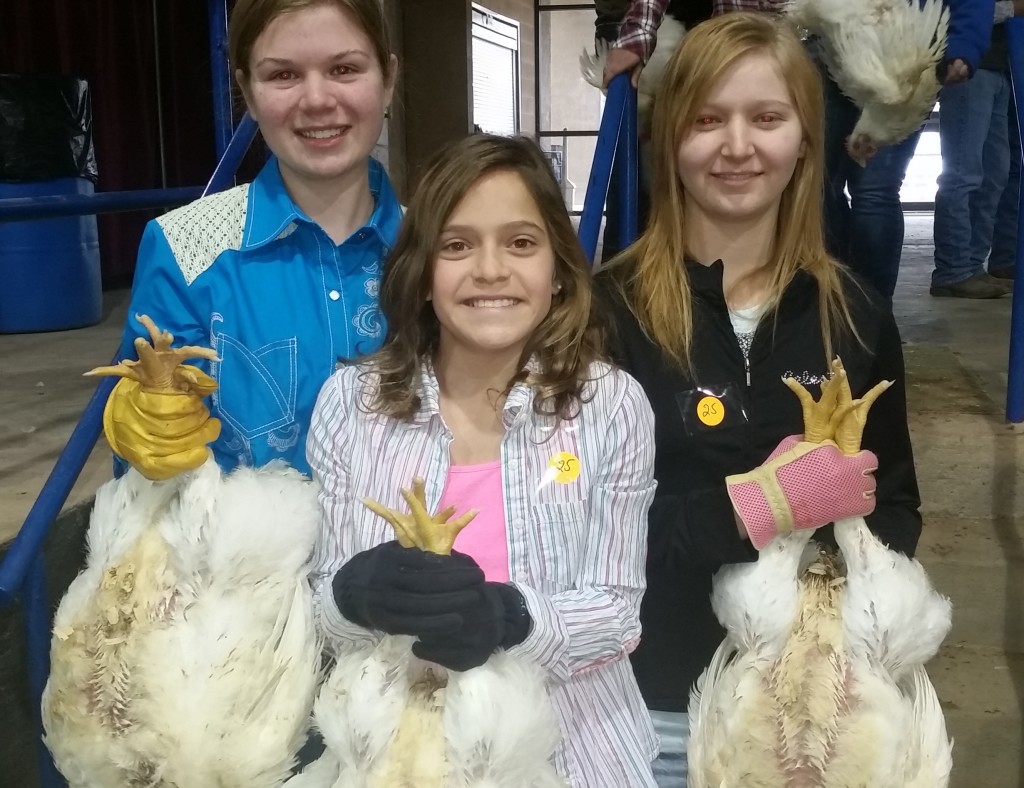
2015 NETLA Chickens
With intensive rain and wintry weather, 2015 is coming to an end. Please allow me to wish you a happy 2016 on behalf of the Hopkins County Extension Office staff and volunteers.
As we get ready to 2016, our 4-H and FFA NETLA showers of poultry must get ready for birds by January 14, 2016.
- OBSERVE ALL SHOW RULES AND REGULATIONS from NETLA governing the broiler show. NETLA poultry show allow the exhibition of both pullets and cockerels.
- Raised poultry only provided by NETLA superintendent.
- Use top-quality feeds.
- Follow recommended management practices during the entire brooding and growing period.
- Keep careful records of all expenses and receipts.
- Cull birds closely and select the show entry properly. Broiler projects are popular with 4-H and FFA members and are an integral part of most youth livestock shows.
NETLA show limit the number of chicks ordered to 25 or 50 per exhibitor. Birds not shown can be slaughtered for home use or sold locally to special markets.
Expensive housing and equipment are not necessary. However, a clean, dry structure that can be well ventilated, a brooder or heat lamps to warm the chicks and feeding and watering equipment are needed. Provide at least 2 square feet of floor space per broiler. Openings on three sides of the building provide plenty of fresh air for the birds. Plastic sheeting can be used to close sides during brooding and in cold weather. Make certain the concrete or dirt floor is at least 6 inches above ground level to prevent flooding.The roof overhang should be sufficient to effectively protect against blowing rain. Before chicken arrive Clean and disinfect the poultry house, feeders and waterers at least two weeks before the chicks arrive. Wash the house down with soap and water. Then spray a commercial disinfectant labeled for use in poultry houses. Be prepared for the chicks 2 days in advance. Put at least 4 inches of litter on the floor of the cleaned disinfected house. Wood shavings, cane fiber, coarse dry sawdust, peanut hulls or rice hulls make good litter. Hay makes very poor litter. Keep all sticks, boards and sharp objects away from the broiler house. Construct a cardboard brooder guard (brooder circle) to keep chicks near heat, water and feed. The brooder guard should be 14 to 18 inches high and must be a minimum of 5 feet in diameter for 50 chicks. When chicks are 7 days old, remove the guard and allow them full freedom of the pen. Electric heat lamps (infrared bulbs) are good heat sources for brooding chicks. Two 125-watt bulbs per 50 chicks are recommended. Make certain lamps are secured so they cannot fall to the litter and create a fire hazard. The lamps should hang so that the bottoms are 18 to 24 inches from the litter. Lamps can be raised or lowered depending on temperature conditions. Place waterers a good distance from the lamps to prevent splashing water from cracking the hot bulbs.If a gas or an electric hover-type brooder is used, it should operate at a temperature of approximately 92 degrees to 95 degrees F. Gradually reduce the temperature 5 degrees each week until the birds are 3 to 4 weeks old or until the house temperature reaches 70 degrees F. When chicks are comfortable, they will bed down in a semicircle around the perimeter of the heat zone. If cold, chicks will crowd near the heat source. If too warm, they will move to the outer limits of the brooder guard. Chilling can stunt chicks. In cold weather the heat source should be turned on 48 hours before chicks arrive to adequately heat the litter. After birds reach 4 weeks of age, the ideal temperature range is 60 to 75 degrees F. When winter temperatures permit, the house should be partially opened to improve airflow and remove moisture. Supplemental heat may be needed when the outside temperature is low. In hot weather, fans or evaporative coolers are used to cool birds more than 4 weeks old. Provide all-night light for broilers and roasters. Twenty-four-hour lighting (natural and artificial) improves feathering and increases weight, especially during the summer months. Hang a 40-watt bulb at least 6 feet above birds after removing heat lamps.
TO ALL NETLA EXHIBITORS: NETLA Participant/Parent Meeting – This meeting is very beneficial to all exhibitors, especially to those who are showing for the 1st time!
Sunday, January 10th – 2:00 p.m. at the Extension Office (conference room in back). Kevin Gibson, NETLA President and the different specie superintendents will be there to answer your questions and give information about the show and sale! For more information on this or any other agricultural topic please call the Hopkins County Extension Office at 903-885-3443 or email me at [email protected].







